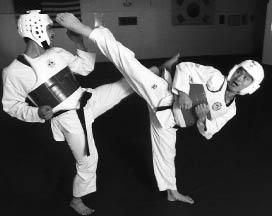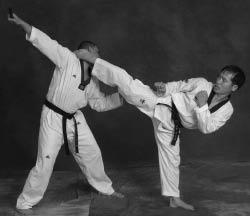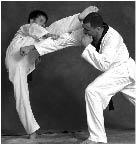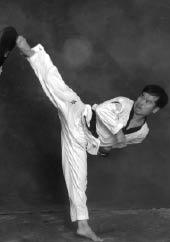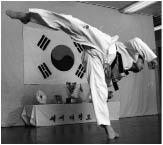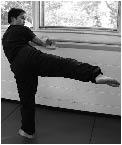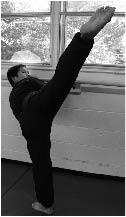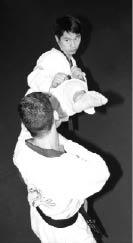Complete Kicking (17 page)
Authors: Turtle Press

When the opponent lands after an attack, throw a front leg whip kick to the ear.
As the opponent raises his leg for axe kick, launch a whip kick counterattack.
SELF-DEFENSE APPLICATION: Use a whip kick to the neck of an opponent preparing to attack.
MARTIAL ARTS APPLICATION: Right: In a pre-arranged step sparring technique, grab the opponent as you kick over his punching arm.
range of motion
Range of motion, or ROM, is the measurable distance between the flexed position and the extended position of a joint. The greater the ROM of your kick is, the more power it generates. ROM can be increased by improving flexibility of the muscles in the legs and torso, and of the joints in the hip, spine and knee.
Whip kick practice to a hand-held target is an excellent way to improve ROM in a safe way. Avoid kicking immovable targets with whip kick.
For advanced practitioners, additional follow through after a whip kick is a good way to increase power.
The greater the range of motion in your kick, the more power your kick generates; the more flexible you are, the greater range of motion you have. The exercise shown here will increase the range of motion and flexibility of your hips for whip kick.
Holding the bar, point your toes and lift your right leg to the left, across your body. This stretches your hip and torso muscles.
Begin to rotate your upper body to the right and open your hips as you raise your leg. This strengthens the muscles of the buttocks while opening the hips.
Continue raising your leg, with your toes pointed. The final position of this stretch is the same as the moment of impact for whip kick. This stretches the hip joint and the muscles in the front of the leg.
common mistakes
MISTAKE 1: Exposing your torso to the opponent during or after kicking.
SOLUTION: This is generally caused by poor posture or kicking too slowly. Be sure to keep your hands and arms close to your body in a guarding position, whip your kick quickly across the target and avoid spinning your torso toward the target after kicking.
MISTAKE 2: Kicking too short or with limited range of motion.
SOLUTION: The main causes are lack of flexibility and coordination. Whip kick is a complex movement that works against the natural tendencies of the body because it forces the spine to bend backward. Improving the flexibility and strength of your back and ab muscles in addition to stretching your legs and hips will correct this problem.
• remember
1. Keep your head straight.
2. Firmly plant the standing foot.
3. Pivot your foot for a quick and smooth rotation of the body.
4. Keep your kicking leg free of tension.
Extend your foot about 6-12 inches in front of the intended target. More than this and your kick will be too wide. Less and you will not have enough space to generate a powerful slapping motion prior to contacting the target.
• avoid
1. Kicking too high
2. Exposing your torso to the opponent after kicking
3. Kicking too slowly and exposing vital targets to the opponent
TWIST KICK
Other books
Beijing Bastard by Val Wang
Heirs of Acadia - 02 - The Innocent Libertine by T. Davis Bunn
The Terran Representative by Monarch, Angus
Bad Blood by Mary Monroe
Enchanted Rendezvous: A Tangled Hearts Romance by Ward, Rebecca
Heat Of The Moment (Brooklyn Heat) by Marx, Locklyn
Between Darkness and Light Trilogy by Brianna Hawthorne
Search (The Empire Chronicles #2) by Ivy, Alyssa Rose
Gecko by Douglas, Ken
The Probability of Murder by Ada Madison

